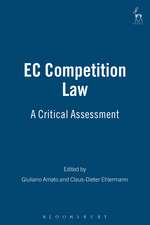The Metaphysics of Market Power: The Zero-sum Competition and Market Manipulation Approach: Hart Studies in Competition Law
Autor George Raitten Limba Engleză Hardback – mai 2019
| Toate formatele și edițiile | Preț | Express |
|---|---|---|
| Paperback (1) | 313.74 lei 43-57 zile | |
| Bloomsbury Publishing – 16 dec 2020 | 313.74 lei 43-57 zile | |
| Hardback (1) | 571.16 lei 22-36 zile | |
| Bloomsbury Publishing – mai 2019 | 571.16 lei 22-36 zile |
Din seria Hart Studies in Competition Law
- 30%
 Preț: 956.51 lei
Preț: 956.51 lei - 21%
 Preț: 275.26 lei
Preț: 275.26 lei - 18%
 Preț: 313.74 lei
Preț: 313.74 lei - 18%
 Preț: 313.07 lei
Preț: 313.07 lei -
 Preț: 315.54 lei
Preț: 315.54 lei - 22%
 Preț: 270.75 lei
Preț: 270.75 lei - 30%
 Preț: 540.54 lei
Preț: 540.54 lei - 27%
 Preț: 777.24 lei
Preț: 777.24 lei - 14%
 Preț: 893.15 lei
Preț: 893.15 lei - 30%
 Preț: 539.18 lei
Preț: 539.18 lei - 21%
 Preț: 217.35 lei
Preț: 217.35 lei -
 Preț: 365.91 lei
Preț: 365.91 lei - 22%
 Preț: 238.22 lei
Preț: 238.22 lei - 30%
 Preț: 779.09 lei
Preț: 779.09 lei - 18%
 Preț: 313.46 lei
Preț: 313.46 lei - 22%
 Preț: 261.17 lei
Preț: 261.17 lei - 23%
 Preț: 255.76 lei
Preț: 255.76 lei - 18%
 Preț: 299.96 lei
Preț: 299.96 lei - 21%
 Preț: 235.29 lei
Preț: 235.29 lei - 22%
 Preț: 250.09 lei
Preț: 250.09 lei - 18%
 Preț: 322.05 lei
Preț: 322.05 lei - 30%
 Preț: 894.38 lei
Preț: 894.38 lei - 22%
 Preț: 780.23 lei
Preț: 780.23 lei - 30%
 Preț: 539.57 lei
Preț: 539.57 lei - 24%
 Preț: 189.80 lei
Preț: 189.80 lei - 30%
 Preț: 837.39 lei
Preț: 837.39 lei -
 Preț: 319.13 lei
Preț: 319.13 lei - 22%
 Preț: 251.65 lei
Preț: 251.65 lei - 30%
 Preț: 569.22 lei
Preț: 569.22 lei - 30%
 Preț: 961.39 lei
Preț: 961.39 lei - 27%
 Preț: 1136.75 lei
Preț: 1136.75 lei
Preț: 571.16 lei
Preț vechi: 817.32 lei
-30% Nou
Puncte Express: 857
Preț estimativ în valută:
109.29€ • 114.40$ • 90.97£
109.29€ • 114.40$ • 90.97£
Carte disponibilă
Livrare economică 10-24 martie
Preluare comenzi: 021 569.72.76
Specificații
ISBN-13: 9781509928071
ISBN-10: 1509928073
Pagini: 328
Dimensiuni: 156 x 234 x 28 mm
Greutate: 0.63 kg
Editura: Bloomsbury Publishing
Colecția Hart Publishing
Seria Hart Studies in Competition Law
Locul publicării:London, United Kingdom
ISBN-10: 1509928073
Pagini: 328
Dimensiuni: 156 x 234 x 28 mm
Greutate: 0.63 kg
Editura: Bloomsbury Publishing
Colecția Hart Publishing
Seria Hart Studies in Competition Law
Locul publicării:London, United Kingdom
Caracteristici
Proposes normative standards within which a legal theory of liability for misuse of market power can be framed
Notă biografică
George Raitt is a Consultant at Piper Alderman, Melbourne and Lecturer at the Faculty of Law, Monash University.
Cuprins
I. The Problem II. Australia's Reform Process III. The Proposed Market Manipulation Approach IV. Implications of the Study beyond the Present Scope V. The Problematic Role of Efficiency VI. Differing Views of the World VII. Economic Models and the Paradigm of Competition VIII. The Overseas Experience IX. What Difference Will Market Manipulation Theory Make? X. Application to the Digital Economy XI. Outline of the Chapters XII. Effective Date of Law PART ITHE THEORETICAL FRAMEWORK1. Market Power in Economics and Law I. Introduction II. Policy Objectives and Concepts of Efficiency III. Economic Models and the Paradigm of Competition IV. Market Manipulation Laws in Securities Markets V. Thought Experiment: Incumbent Response to New Entry VI. Norms in Zero-Sum Competition VII. Zero-Sum Competition, Market Manipulation and Efficiency VIII. Conclusion 2. The Mischief and Australia's Institutional Response I. Introduction II. The Continuing Influence of the SCP Approach in Australia III. Australia's Institutional Division of Functions between Courts and Agencies IV. Institutional Arrangements in the EU and the US: Court-Centred or Agency-Centred? V. Conclusion 3. Competition and Efficiency Effects in Europe, North America and Australia I. Introduction II. The Current Australian Effects Test Outside Section 46 III. The Harper Review Effects Test and the Role of Efficiency EffectsIV. EU Abuse of Dominance and Defences V. US Monopolisation and Defences VI. Efficiency in the Law of Securities Market Manipulation VII. Adapting Efficiency as a Legal Concept VIII. Zero-Sum Competition, Market Manipulation and Efficiency IX. Conclusion PART IITESTING MARKET MANIPULATION AND EFFICIENCY APPROACHESIntroduction4. Refusal to Deal and Margin Squeeze I. Introduction II. Queensland Wire: Factual Matrix III. Gaps in the Factual Matrix IV. Queensland Wire under Harper Section 46 V. Queensland Wire under Market Manipulation VI. Melway: Factual Matrix VII. Melway under Harper Section 46 VIII. Melway under Market Manipulation IX. Conclusion 5. Predatory Pricing I. Introduction II. Boral: Factual Matrix III. Gaps in the Factual Matrix IV. Boral under Harper Section 46 V. Boral under Market Manipulation VI. Conclusion 6. Meeting Competition I. Introduction II. Rural Press: Factual Matrix III. Gaps in the Factual Matrix IV. Rural Press under Harper Section 46 V. Rural Press under Market Manipulation VI. Conclusion 7. Raising Rivals' Costs I. Introduction II. Cement Australia: Factual Matrix III. Gaps in the Factual Matrix IV. Cement Australia under Harper Section 46 V. Cement Australia under Market Manipulation VI. Conclusion 8. Bundling I. Introduction II. Baxter: Factual Matrix III. Gaps in the Factual Matrix IV. Baxter under Harper Section 46 V. Baxter under Market Manipulation VI. The Implications of Pfizer VII. Conclusion 9. Institutional and Procedural Implications I. Introduction II. NT Power III. The Burden of Proof IV. Conclusion PART IIICONCLUSION10. Findings and Recommendations I. Introduction II. The Concept of Market Power III. Paradigms of Competition and Norms of Conduct IV. Forensic Assessment of Misuse of Market Power: Conclusions from the Case Studies V. Implications for Competition Law
Recenzii
[T]he reader will be rewarded by a better understanding of the law surrounding s 46 as it is, and how the author would have it be.











